Product Info Summary
| SKU: | A00901-3 |
|---|---|
| Size: | 100 μg/vial |
| Reactive Species: | Mouse, Rat |
| Host: | Rabbit |
| Application: | Flow Cytometry, IF, IHC, ICC, WB |
Customers Who Bought This Also Bought
Product info
Product Name
Anti-VEGF Receptor 2/Kdr Antibody Picoband®
View all VEGFR2/KDR/Flk-1 Antibodies
SKU/Catalog Number
A00901-3
Size
100 μg/vial
Form
Lyophilized
Description
Boster Bio Anti-VEGF Receptor 2/Kdr Antibody Picoband® catalog # A00901-3. Tested in Flow Cytometry, IF, IHC, ICC, WB applications. This antibody reacts with Mouse, Rat. The brand Picoband indicates this is a premium antibody that guarantees superior quality, high affinity, and strong signals with minimal background in Western blot applications. Only our best-performing antibodies are designated as Picoband, ensuring unmatched performance.
Storage & Handling
Store at -20˚C for one year from date of receipt. After reconstitution, at 4˚C for one month. It can also be aliquotted and stored frozen at -20˚C for six months. Avoid repeated freeze-thaw cycles.
Cite This Product
Anti-VEGF Receptor 2/Kdr Antibody Picoband® (Boster Biological Technology, Pleasanton CA, USA, Catalog # A00901-3)
Host
Rabbit
Contents
Each vial contains 4mg Trehalose, 0.9mg NaCl, 0.2mg Na2HPO4, 0.05mg NaN3.
Clonality
Polyclonal
Isotype
Rabbit IgG
Immunogen
E. coli-derived mouse VEGF Receptor 2 recombinant protein (Position: A20-L244).
*Blocking peptide can be purchased. Costs vary based on immunogen length. Contact us for pricing.
Cross-reactivity
No cross-reactivity with other proteins.
Reactive Species
A00901-3 is reactive to Kdr in Mouse, Rat
Reconstitution
Add 0.2ml of distilled water will yield a concentration of 500ug/ml.
Observed Molecular Weight
150 kDa
Calculated molecular weight
78265 MW
Background of VEGFR2/KDR/Flk-1
KDR (Kinase Insert Domain Receptor), also known as FLK1, VEGFR or VEGFR2, is a VEGF receptor. KDR is the human gene encoding it. Vascular endothelial growth factor (VEGF) is the only mitogen that specifically acts on endothelial cells. Its expression is upregulated by hypoxia, and its cell-surface receptor, known as fetal liver kinase-1 (Flk1) in mouse, is exclusively expressed in endothelial cells. Flk1 is the mouse homolog of KDR.
Antibody Validation
Boster validates all antibodies on WB, IHC, ICC, Immunofluorescence, and ELISA with known positive control and negative samples to ensure specificity and high affinity, including thorough antibody incubations.
Application & Images
Applications
A00901-3 is guaranteed for Flow Cytometry, IF, IHC, ICC, WB Boster Guarantee
Assay Dilutions Recommendation
The recommendations below provide a starting point for assay optimization. The actual working concentration varies and should be decided by the user.
Western blot, 0.1-0.5μg/ml
Immunohistochemistry (Paraffin-embedded Section), 0.5-1μg/ml
Immunocytochemistry/Immunofluorescence, 2μg/ml
Flow Cytometry (Fixed), 1-3μg/1x106 cells
Positive Control
WB: Marker, mouse heart tissue, mouse thymus tissue, mouse spleen tissue, mouse kidney tissuemouse brain tissue, mouse lung tissuemouse HEPA1-6 whole cell, mouse NIH3T3 whole cellThe membrane was incubated with rabbit anti-VEGF Receptor 2 antigen affinity purified polyclonal antibody (Catalog # A00901-3) at 10 μg/mL overnight at 4°C, then washed with TBS-01%Tween 3 times with 5 minutes each and probed with a goat anti-rabbit IgG-HRP secondary antibody at a dilution of 1:5000 for 15 hour at RTThe signal is developed using an Enhanced Chemiluminescent detection (ECL) kit (Catalog # EK1002) with Tanon 5200 system
IHC: mouse kidney tissue, rat kidney tissue
ICC/IF: NIH3T3 cell
FCM: MFC cell, LLC cell
Validation Images & Assay Conditions
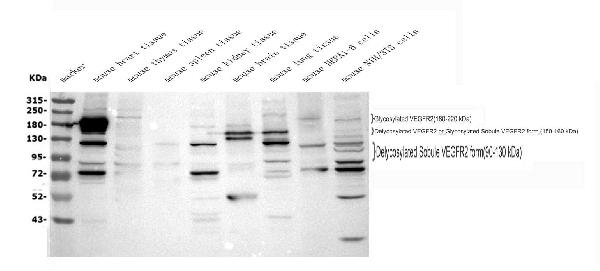
Click image to see more details
Figure 1. Western blot analysis of VEGF Receptor 2 using anti-VEGF Receptor 2 antibody (A00901-3).
The sample well of each lane was loaded with 50ug of sample under reducing conditions.
Lane 1: Marker
Lane 2: mouse heart tissue lysates,
Lane 3: mouse thymus tissue lysates,
Lane 4: mouse spleen tissue lysates,
Lane 5: mouse kidney tissue lysates.
Lane 6: mouse brain tissue lysates,
Lane 5: mouse lung tissue lysates.
Lane 7: mouse HEPA1-6 whole cell lysates,
Lane 8: mouse NIH3T3 whole cell lysates.
The membrane was incubated with rabbit anti-VEGF Receptor 2 antigen affinity purified polyclonal antibody (Catalog # A00901-3) at 1.0 μg/mL overnight at 4°C, then washed with TBS-0.1%Tween 3 times with 5 minutes each and probed with a goat anti-rabbit IgG-HRP secondary antibody at a dilution of 1:5000 for 1.5 hour at RT. The signal is developed using an Enhanced Chemiluminescent detection (ECL) kit (Catalog # EK1002) with Tanon 5200 system.
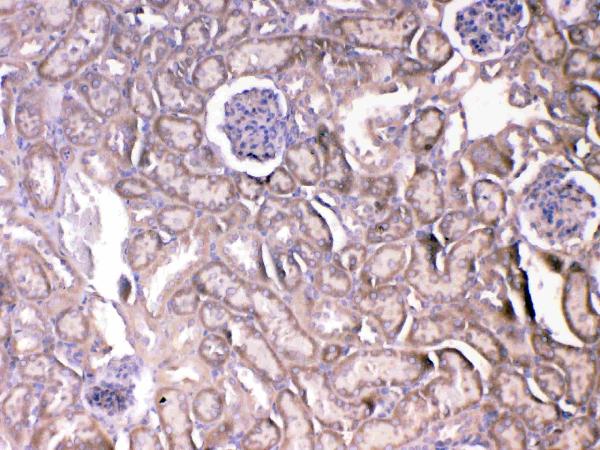
Click image to see more details
Figure 2. IHC analysis of VEGF Receptor 2 using anti-VEGF Receptor 2 antibody (A00901-3).
VEGF Receptor 2 was detected in paraffin-embedded section of mouse kidney tissue. Heat mediated antigen retrieval was performed in citrate buffer (pH6, epitope retrieval solution) for 20 mins. The tissue section was blocked with 10% goat serum. The tissue section was then incubated with 1μg/ml rabbit anti-VEGF Receptor 2 Antibody (A00901-3) overnight at 4°C. Biotinylated goat anti-rabbit IgG was used as secondary antibody and incubated for 30 minutes at 37°C. The tissue section was developed using Strepavidin-Biotin-Complex (SABC)(Catalog # SA1022) with DAB as the chromogen.
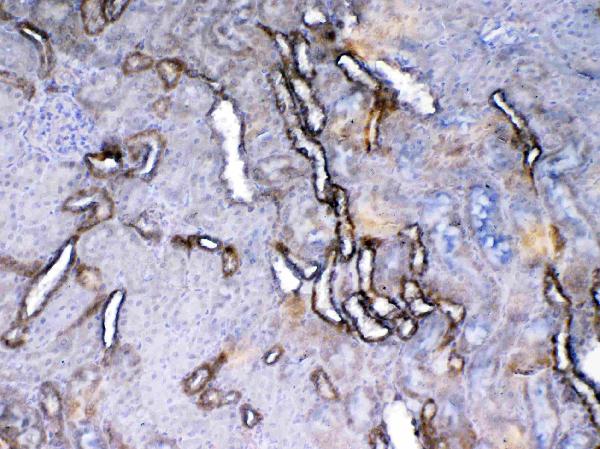
Click image to see more details
Figure 3. IHC analysis of VEGF Receptor 2 using anti-VEGF Receptor 2 antibody (A00901-3).
VEGF Receptor 2 was detected in paraffin-embedded section of rat kidney tissue. Heat mediated antigen retrieval was performed in citrate buffer (pH6, epitope retrieval solution) for 20 mins. The tissue section was blocked with 10% goat serum. The tissue section was then incubated with 1μg/ml rabbit anti-VEGF Receptor 2 Antibody (A00901-3) overnight at 4°C. Biotinylated goat anti-rabbit IgG was used as secondary antibody and incubated for 30 minutes at 37°C. The tissue section was developed using Strepavidin-Biotin-Complex (SABC)(Catalog # SA1022) with DAB as the chromogen.
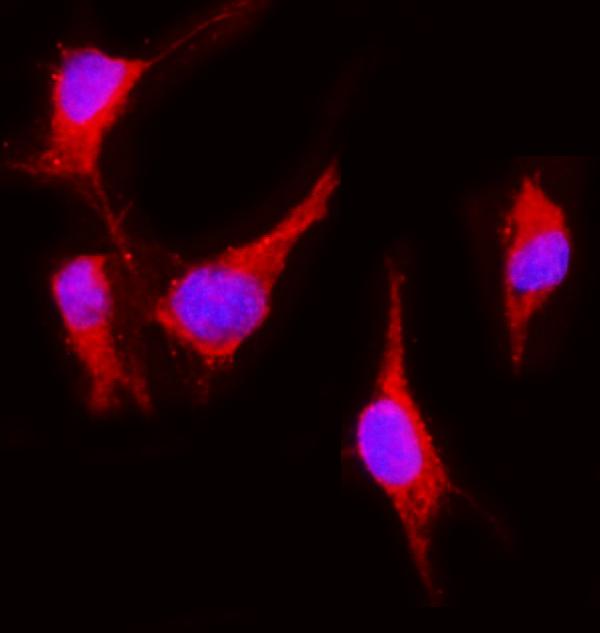
Click image to see more details
Figure 4. IF analysis of VEGF Receptor 2 using anti-VEGF Receptor 2 antibody (A00901-3).
VEGF Receptor 2 was detected in immunocytochemical section of NIH3T3 cells. Enzyme antigen retrieval was performed using IHC enzyme antigen retrieval reagent (AR0022) for 15 mins. The cells were blocked with 10% goat serum. And then incubated with 2μg/mL rabbit anti-VEGF Receptor 2 Antibody (A00901-3) overnight at 4°C. Cy3 Conjugated Goat Anti-Rabbit IgG (BA1032) was used as secondary antibody at 1:100 dilution and incubated for 30 minutes at 37°C. The section was counterstained with DAPI. Visualize using a fluorescence microscope and filter sets appropriate for the label used.
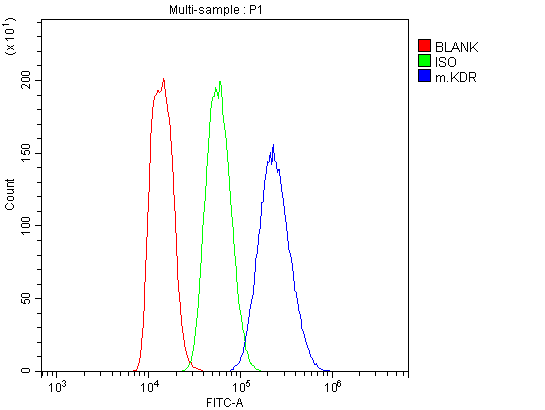
Click image to see more details
Figure 5. Flow Cytometry analysis of MFC cells using anti-VEGF Receptor 2 antibody (A00901-3).
Overlay histogram showing MFC cells stained with A00901-3 (Blue line). To facilitate intracellular staining, cells were fixed with 4% paraformaldehyde and permeabilized with permeabilization buffer. The cells were blocked with 10% normal goat serum. And then incubated with rabbit anti-VEGF Receptor 2 Antibody (A00901-3,1μg/1x106 cells) for 30 min at 20°C. DyLight®488 conjugated goat anti-rabbit IgG (BA1127, 5-10μg/1x106 cells) was used as secondary antibody for 30 minutes at 20°C. Isotype control antibody (Green line) was rabbit IgG (1μg/1x106) used under the same conditions. Unlabelled sample without incubation with primary antibody and secondary antibody (Red line) was used as a blank control.
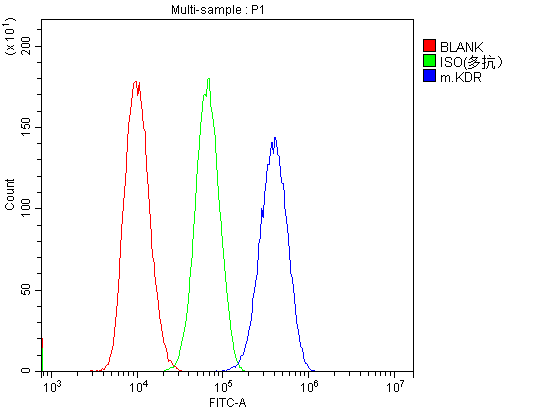
Click image to see more details
Figure 6. Flow Cytometry analysis of LLC cells using anti-VEGF Receptor 2 antibody (A00901-3).
Overlay histogram showing LLC cells stained with A00901-3 (Blue line). To facilitate intracellular staining, cells were fixed with 4% paraformaldehyde and permeabilized with permeabilization buffer. The cells were blocked with 10% normal goat serum. And then incubated with rabbit anti-VEGF Receptor 2 Antibody (A00901-3,1μg/1x106 cells) for 30 min at 20°C. DyLight®488 conjugated goat anti-rabbit IgG (BA1127, 5-10μg/1x106 cells) was used as secondary antibody for 30 minutes at 20°C. Isotype control antibody (Green line) was rabbit IgG (1μg/1x106) used under the same conditions. Unlabelled sample without incubation with primary antibody and secondary antibody (Red line) was used as a blank control.
Protein Target Info & Infographic
Gene/Protein Information For Kdr (Source: Uniprot.org, NCBI)
Gene Name
Kdr
Full Name
Vascular endothelial growth factor receptor 2
Weight
78265 MW
Superfamily
protein kinase superfamily
Alternative Names
Vascular endothelial growth factor receptor 2; VEGFR-2; Fetal liver kinase 1; FLK-1; Kinase NYK; Protein-tyrosine kinase receptor flk-1; CD309; Kdr; Flk-1; Flk1 KDR CD309, FLK1, VEGFR, VEGFR2 kinase insert domain receptor vascular endothelial growth factor receptor 2|fetal liver kinase-1|kinase insert domain receptor (a type III receptor tyrosine kinase)|protein-tyrosine kinase receptor Flk-1|soluble VEGFR2|tyrosine kinase growth factor receptor
*If product is indicated to react with multiple species, protein info is based on the gene entry specified above in "Species".For more info on Kdr, check out the Kdr Infographic

We have 30,000+ of these available, one for each gene! Check them out.
In this infographic, you will see the following information for Kdr: database IDs, superfamily, protein function, synonyms, molecular weight, chromosomal locations, tissues of expression, subcellular locations, post-translational modifications, and related diseases, research areas & pathways. If you want to see more information included, or would like to contribute to it and be acknowledged, please contact [email protected].
Specific Publications For Anti-VEGF Receptor 2/Kdr Antibody Picoband® (A00901-3)
Hello CJ!
A00901-3 has been cited in 11 publications:
*The publications in this section are manually curated by our staff scientists. They may differ from Bioz's machine gathered results. Both are accurate. If you find a publication citing this product but is missing from this list, please let us know we will issue you a thank-you coupon.
Fructopyrano-(1→4)-glucopyranose inhibits the proliferation of liver cancer cells and angiogenesis in a VEGF/VEGFR dependent manner
Activation of Endogenous Cardiac Stem Cells by Apelin-13 in Infarcted Rat Heart:
Ghrelin promotes the differentiation of human embryonic stem cells in infarcted cardiac microenvironment
Infarcted cardiac microenvironment may hinder cardiac lineage differentiation of human embryonic stem cells
Kong Z,Chen M,Jiang J,Zhu J,Liu Y. A new method of culturing rat bone marrow endothelial progenitor cells in vitro. Cardiovasc Diagn Ther.2020 Oct;10(5):1270-1279.doi:10.21037/cdt-20-536.PMID:33224751;PMCID:PMC7666940.
Species: Rat
A00901-3 usage in article: APP:ICC, SAMPLE:EPCS, DILUTION:1:10
A novel multi-target RNAi adenovirus inhibits hepatoma cell proliferation, migration, and induction of angiogenesis
Yan-Ping D, Xiao-Qin G, Xiao Ping M, Ying Quan Y. Biomed Res Int. 2017;2017:2597256. doi: 10.1155/2017/2597256. Epub 2017 Jul 16. Effects of Chronic Exposure to Sodium Arsenite on Expressions of VEGF and VEGFR2 Proteins in the Epididymis of Rats
Zhu Y, Tuerxun A, Hui Y, Abliz P. Exp Ther Med. 2014 Aug;8(2):647-651. Epub 2014 Jun 12. Effects Of Propranolol And Isoproterenol On Infantile Hemangioma Endothelial Cells In Vitro.
Liu M, Yang S, Zhang D, Shui P, Song S, Yao J, Dai Y, Sun Q. Int J Clin Exp Med. 2014 Nov 15;7(11):3859-69. Ecollection 2014. Fructopyrano-(1
Fu Y, Zhao Z, Wu Y, Wu K, Xu X, Liu Y, Tong C. J Ethnopharmacol. 2012 Jan 6;139(1):26-33. Doi: 10.1016/J.Jep.2011.08.077. Epub 2011 Nov 10. Therapeutic Mechanisms Of Tongmai Dasheng Tablet On Tripterygium Glycosides Induced Rat Model For Premature...
Recommended Resources
Here are featured tools and databases that you might find useful.
- Boster's Pathways Library
- Protein Databases
- Bioscience Research Protocol Resources
- Data Processing & Analysis Software
- Photo Editing Software
- Scientific Literature Resources
- Research Paper Management Tools
- Molecular Biology Software
- Primer Design Tools
- Bioinformatics Tools
- Phylogenetic Tree Analysis
Customer Reviews
Have you used Anti-VEGF Receptor 2/Kdr Antibody Picoband®?
Submit a review and receive an Amazon gift card.
- $30 for a review with an image
0 Reviews For Anti-VEGF Receptor 2/Kdr Antibody Picoband®
Customer Q&As
Have a question?
Find answers in Q&As, reviews.
Can't find your answer?
Submit your question
5 Customer Q&As for Anti-VEGF Receptor 2/Kdr Antibody Picoband®
Question
My boss were happy with the WB result of your anti-VEGF Receptor 2/Kdr antibody. However we have been able to see positive staining in umbilical vein isoform 1: cell membrane using this antibody. Is that expected? Could you tell me where is KDR supposed to be expressed?
Verified Customer
Verified customer
Asked: 2019-11-21
Answer
From literature, umbilical vein does express KDR. Generally KDR expresses in cell junction. endoplasmic, isoform 1: cell membrane. Regarding which tissues have KDR expression, here are a few articles citing expression in various tissues:
Umbilical vein, Pubmed ID: 15815621, 1656371, 7559454
Boster Scientific Support
Answered: 2019-11-21
Question
Our lab want to know about using your anti-VEGF Receptor 2/Kdr antibody for branching morphogenesis of an epithelial tube studies. Has this antibody been tested with western blotting on mouse kidney tissue? We would like to see some validation images before ordering.
Verified Customer
Verified customer
Asked: 2019-07-15
Answer
Thank you for your inquiry. This A00901-3 anti-VEGF Receptor 2/Kdr antibody is tested on mouse kidney tissue, rat kidney tissue. It is guaranteed to work for ELISA, Flow Cytometry, IHC-P, IHC-F, ICC, WB in mouse, rat. Our Boster guarantee will cover your intended experiment even if the sample type has not been be directly tested.
Boster Scientific Support
Answered: 2019-07-15
Question
Our lab used your anti-VEGF Receptor 2/Kdr antibody for Flow Cytometry on lung a few years ago. I am using mouse, and We want to use the antibody for WB next. I am interested in examining lung as well as umbilical vein in our next experiment. Could you please give me some suggestion on which antibody would work the best for WB?
L. Huang
Verified customer
Asked: 2014-05-15
Answer
I took a look at the website and datasheets of our anti-VEGF Receptor 2/Kdr antibody and it appears that A00901-3 has been validated on mouse in both Flow Cytometry and WB. Thus A00901-3 should work for your application. Our Boster satisfaction guarantee will cover this product for WB in mouse even if the specific tissue type has not been validated. We do have a comprehensive range of products for WB detection and you can check out our website bosterbio.com to find out more information about them.
Boster Scientific Support
Answered: 2014-05-15
Question
We are currently using anti-VEGF Receptor 2/Kdr antibody A00901-3 for mouse tissue, and we are content with the ICC results. The species of reactivity given in the datasheet says mouse, rat. Is it possible that the antibody can work on primate tissues as well?
P. Johnson
Verified customer
Asked: 2013-10-09
Answer
The anti-VEGF Receptor 2/Kdr antibody (A00901-3) has not been validated for cross reactivity specifically with primate tissues, but there is a good chance of cross reactivity. We have an innovator award program that if you test this antibody and show it works in primate you can get your next antibody for free. Please contact me if I can help you with anything.
Boster Scientific Support
Answered: 2013-10-09
Question
We have seen staining in rat lung. Do you have any suggestions? Is anti-VEGF Receptor 2/Kdr antibody supposed to stain lung positively?
N. Gonzalez
Verified customer
Asked: 2013-04-25
Answer
Based on literature lung does express KDR. Based on Uniprot.org, KDR is expressed in lung, umbilical vein, among other tissues. Regarding which tissues have KDR expression, here are a few articles citing expression in various tissues:
Umbilical vein, Pubmed ID: 15815621, 1656371, 7559454
Boster Scientific Support
Answered: 2013-04-25





